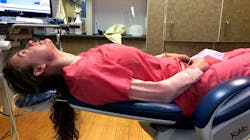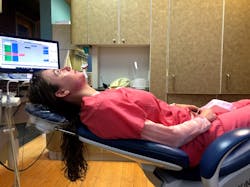Common ergonomic errors and solutions for dental hygienists
Editor's note: Read Stephanie Botts' recent article about ergonomics: Nearly 100% of hygienists have pain on the job. What can you do?
Ergonomics—people’s efficiency in their working environment—helps decrease muscle fatigue, increase productivity, and reduce the number and severity of work-related musculoskeletal disorders (MSDs).1 The goal of ergonomics is to prevent soft tissue injuries and MSDs caused by sudden or sustained exposure to force, vibration, repetitive motion, and awkward posture.2
In the case of dental hygienists, this involves equipment placement and selection and evaluating their work habits to ensure proper ergonomics, neutral posture, and support of the body. Although practicing dental hygiene is ergonomically challenging, several common issues have relatively easy solutions that can significantly impact the care delivered and the level of pain or discomfort.
Mindset
Ergonomics is about honoring and respecting the body's unique capabilities and limitations and adjusting the workplace to support them. Most hygienists are provided a fixed operatory and a patient and they adjust their bodies to what is provided. This often leads to them holding static, awkward postures, bending, twisting, reaching, and performing repetitive motions during patient care.
When attempting to practice ergonomically, most hygienists need to adopt a radical change in mindset. They must put the health of their body first when entering the operatory and evaluating how they can adjust their provided workspace to support them.
Patient positioning
A common mistake by dental hygienists is not adjusting the patient chair or the patient depending on the area they’re treating. Taking the time to properly positionn the patient chair and patient will significantly reduce fatigue and pain. In addition, proper patient positioning will allow greater adoption of neutral posture and reduce harmful body movements, such as bending and twisting, that increase the likelihood of MSDs.
A patient's position will depend on which arch the hygienist is treating. When treating the maxillary arch, the patient chair should be fully supine, the headrest tilted back to encourage the chin to raise, and the height low enough to allow the hygienist’s elbows to bend at 90 degrees. The maxillary occlusal plane should be 10 to 20 degrees behind the vertical plane (figure 1 above). This angle is key to preventing leaning forward and it encourages neutral posture when the hygienist is seated at 12 o’clock.
If the mandibular arch is treated, the patient's chair back should be raised 20 to 30 degrees from the horizontal plane, which places them in a semi-supine position. The headrest should be tilted forward to encourage the chin to nod toward the chest, and the height of the patient chair should be lowered to allow the elbows to bend at 90 degrees. The mandibular plane of occlusion should be about 30 degrees elevated from the horizontal plane (figure 2).
To further increase visibility while maintaining a neutral posture, direct the patient using verbal cues to better support working ergonomically. For example, the patient can tilt or rotate their head to visualize better and keep neutral posture.
Equipment placement
Another aspect for dental hygienists to consider is placement of their equipment. As a general rule, it is crucial to keep the most used instruments and equipment close to the hygienist’s body to decrease the need for reaching and leaning. This means the instruments, air/water, suction, and ultrasonic are close. In addition, since a typical hygiene appointment involves adopting different clock positions, hygienists must move their equipment in order to keep it close.
Stretching
Practicing dental hygiene involves holding static, awkward postures for an extended period. This isometrically contracts muscles, which causes the intramuscular pressure to rise. This rise in pressure prevents oxygen and blood flow to the muscles, which would otherwise repair cellular trauma incurred when holding these postures.
Hygienists can begin a stretching program to encourage healthy bloodflow back into the muscles, which will increase cellular healing and reduce pain and fatigue. It is essential to stretch before, during, and after work. Most hygienists incorporate some stretching before or after work, but not during work, likely due to time constraints. It has been shown that taking 20- to 30-second microbreaks every 20 minutes helps reduce the pain and fatigue experienced by dental professionals.3 These microbreaks can easily be taken chairside between scaling and polishing or when changing arches (figure 3).
Practicing dentistry is an extremely physically demanding profession. If done in a nonergonomic fashion, it can push the musculoskeletal system far beyond its capabilities and result in inflammation, pain, loss of motion, dysfunction, and potential disability. However, there are many ergonomic interventions dental hygienists can adopt to decrease this risk and increase job and life satisfaction. By incorporating an ergonomic mindset, correct positioning, ideal equipment placement, and stretches for overworked muscles, dental hygienists can have long and healthy careers.
References
1. Ergonomics. Occupational Safety and Health Administration. Accessed July 3rd, 2021. https://www.osha.gov/ergonomics
2. Ergonomics and musculoskeletal disorders. Centers for Disease Control and Prevention. Reviewed Feb 28, 2018. Accessed July 3, 2021. https://www.cdc.gov/niosh/topics/ergonomics/default.html
3. McLean L, Tingley M, Scott R, Rickards J. Computer terminal work and the benefit of microbreaks. Appl Ergon. 2001;32(3):225-237. DOI: 10.1016/s0003-6870(00)00071-5
Stephanie Botts, BSDH, RDH, CEAS, has been a full-time clinical hygienist for 13 years. She is a certified ergonomics assessment specialist providing both in-office and virtual ergonomics consulting and coaching. Her experience as an ergonomics expert has allowed her to recognize the unique challenges of practicing pain-free. Stephanie believes that by learning practical strategies to optimize proper ergonomics both inside and outside the operatory, dental professionals can practice pain-free and ensure career longevity. Contact her at [email protected], posturepros.net, or (907) 229-4989.
About the Author
Stephanie Botts, BSDH, RDH, CEAS
Stephanie Botts, BSDH, RDH, CEAS, has been a clinical dental hygienist for over 17 years. She is a certified ergonomics assessment specialist providing both in-office and virtual ergonomics consulting and coaching to dental professionals. She also provides CE to dental and dental hygiene associations on ergonomics. Stephanie believes that by learning effective strategies to optimize proper ergonomics, dental professionals can practice pain-free and ensure career longevity. She can be reached at [email protected] or on Instagram at @steph.polishedposture.


